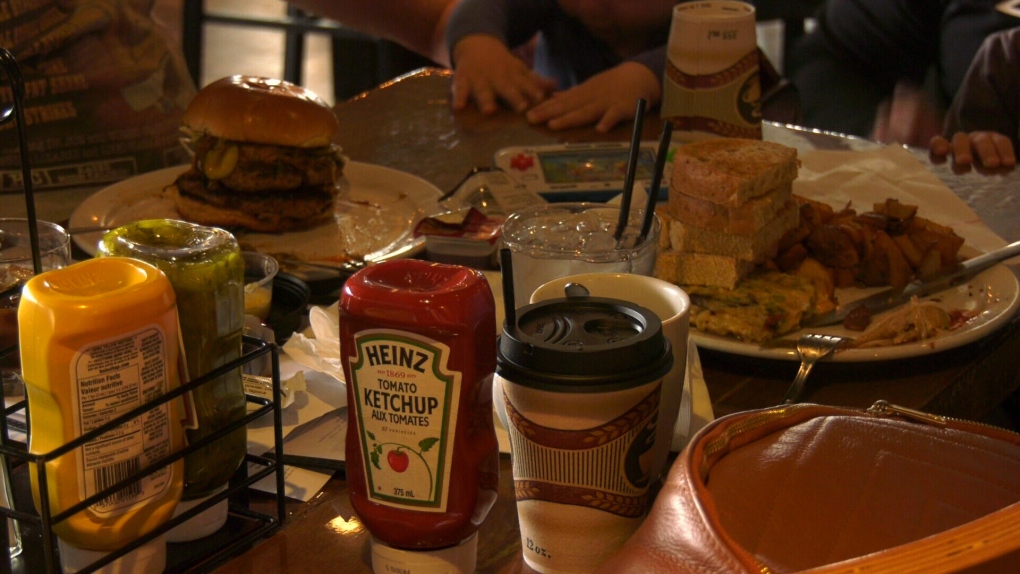“I can tell you that the people that are doing it aren’t the people who are coming here because they’re looking for a sandwich because they’re hungry,” said Ravi Ramberran, “It’s the people who are not afraid of consequences period.”
In the wake of the increase in dine and dashers, Ramberran said his restaurant has ramped up how they deal with it.
“We blast them on Facebook, we hold them, we make them wait for the cops…We do what’s in our power to do.”



One solution would be to pay at the time that you order, but then I’d be horrified at the concept of being asked to tip BEFORE your meal, in which case tipping switches from being mild/borderline extortion to being full-on blatant extortion. So, credit card for deposit would be better, like someone else suggested.
Or, if the point of this isn’t to ask for solutions but to complain about ‘people getting worse’… There’s always been shit-heads and there’s always going to be shit-heads out there. Maybe the percentages are shifting, but if so it’s likely the not-so-new problem of cities growing bigger and feeling less like a community, and if someone doesn’t feel like they have any connection or responsibility to the people that live around them, then this and countless other crimes and social breakdown tend to result. Maybe the nature of the internet and media etc. is making that worse, but if so it’s still only a different flavour to the old and ongoing task of maintaining social cohesion one generation to the next. I admit, some days I almost want to lose faith in that, but it’s gonna take more than an increase in petty theft to do it today.
How about ban tipping and just increase wages+benefits? Such an easy solution you found.
But then what incentives the wait staff to ask what I’d like to order and carry my food out to me?
You’re almost there. You’re almost at the answer.
Urgh… ehm… we should… we should tip cashiers and self-checkouts as well?
That’s the answer, right?
deleted by creator
Just don’t ask for tips, seems like you found a solution for 2 problems
Paying before is a possible solition, but it’s a double-edged sword for restaurants.
I would imagine that the sticker shock would lead to people spending less on their overpriced food and drinks, ignoring the outrageous tip on top of that.
I’d lose my appetite 😂
Also how do you handle things that pop up mid meal? Like a second beer/cocktail with your meal.
I think a deposit when you sit down makes the most sense. If paying by card, then just keep their card on file for the duration of the meal, if cash, then do a small deposit per person - less than the cost of the meal, but enough to make dining and dashing really not worth the risk/effort.
Not exactly perfect, but itd work
They’d probably do it like gas stations… put a $200+ hold on the card, then actually charge the amount you pumped.
Fair point, makes cash customers trickier, but for better or worse, more and more people don’t use cash anyways, so that might be a non issue
I’m not sure sticker shock affects people when it comes to food. Maybe because they are going to buy it no matter what.
Look at the cost of cooking at home. The cost of an average property in Canada’s metros is around $1,000 per square foot. An average kitchen is 100 square feet.
If you buy a house at the age of 30, you might use it for, what, 50 years? It’s not hard to get 5% interest these days, so if you stuck that amount in the bank instead you would have $1.1 M after 50 years. In other words, it costs $60 per day just to have an idle kitchen in your home.
Heaven forbid you actually use it. The average meal takes around 30 minutes to make and cleanup. The average wage is around $30 per hour. If we assume three meals per day, that’s $45 spent. We’re up to $105 per day and we still don’t have any food.
The average person spends $200 per month on groceries. So that brings us up to $111 per day, or nearly $40 per meal. Hope you are a good cook! And I didn’t bother even getting into other costs like electricity, maintenance, etc. associated with owning and operating a kitchen. Doesn’t phase people one bit.
It is true that you can improve upon those numbers if you have a family, but one-person households are the predominant household type in Canada (and increasingly).
You’d never convince me that eating at a restaurant is more economical and cooking at home, even with the math you present.
I mean, when it costs $5 to make pasta for four people at home, or $20 per plate at some cheap diner down the street, I’m not sure I’d want to pile on desert and drinks after seeing the bill before I eat.
An idle kitchen in the home is a sin, especially if money is a factor. But kitchens aren’t really used 24/7. Even an hour of kitchen time per day is going to save you money and time vs multiple restaurant meals, coffee runs, or convenience store snacks.
Nah. Breakfast for most people might involve pouring milk into cereal. 10 seconds at most.
Lunch is often <5 minutes to prepare, add an extra minute if you’re making it for multiple people.
Dinner can take 30 minutes, if you want it to. But in less than 30 minutes of actual kitchen time, you could have had your pressure cooker making meals for the week. You could have made a wonderful cappuccino for you and your partner, and had fresh bread going ready while you did something else.
Tim Hortons 3 x a day? Make it in minutes at home using pennies worth of beans.
Any typical restaurant meal would at a minimum $25 ($10 for lunch) + the time and gas to get there to order it, eat it, then come home. Do that 6x a day (3 meals + snacks) for X number of people in the home, and you’d literally need another income just to feed your family restaurant meals.
I’d argue that one person can be even easier to cook for, since a meal for four can feel one person four times. And a single person doesn’t have to cater to multiple preferences.
The reality is that restaurants are among the most expensive, unnecessary things that most Canadians indulge in. In a time when people are concerned about housing affordability, job insecurity, and the cost of food, it’s almost silly to try to justify eating out these days.
I wouldn’t dream of it. I couldn’t care less about what you think. You are supposed to convince me that cooking at home is more economical.
And? The cost is the same no matter how much you use it. We call these fixed costs. They are as true in a commercial kitchen as a residential kitchen. They are, by far, the largest cost in both cases.
Okay, even if we say three meals at that price, your cost is only $15 - or $5 per meal. Remember, you kept $60 in your pocket from not owning a kitchen: 75 - 60 = 15.
A $25 breakfast sounds pretty swanky, though.
So, like, maybe $30 gross cost – or $30 profit each day (60 - 30 = 30)! Now you’re getting paid to eat!
Easier, but you lose economies of scale. Those fix costs are the same either way, so the more people you can feed, the lesser the cost per person. That $60 becomes $30 per person if you are feeding two.
This is exactly how restaurants are able to feed you for so much less. Each time they feed another customer, the fixed costs divided by each mouth fed goes down. Instead of charging you that $60 to recoup their cost, they only charge you $60 / number of customers.
If you want to set aside some criteria, then I’d be game. Are you including transportation costs per restaurant trip? “Lost wages” in the time it takes to go and then wait for your meal? Delivery fees? Etc.? If so, set out the parameters.
You look at having a kitchen as a loss, while someone else would see it as a bonus for the place you’re paying for to have a roof over your head. Even without a kitchen you could make meals in your bedroom using a simple pressure cooker, or more if you want to expand on your options.
So, if you want to go that route, a kitchen is zero cost, because you can use whatever room you sleep in.
Again, zero cost kitchen per above. You’d be overspending far more than $60 per day, and you’re getting a (likely) unhealthy meal.
Per above, you’re spending specifically more!
No, because rather than making many meals for many people, you’re making many meals for one. No added cost necessary.
Yeah, $20 pasta, $15 sandwich, $6 lattes, $8 for home fries, $3 for pop… much less than what? A banquet wedding dinner? LOL
Maybe do it like gas stations where you pre-auth $200 or $300 then at the end they just charge you for what you end up using.
I.e. pre-auth $200 and then at the end of your meal, get the bill for $100, put down a 15% tip, they only charge your card for $115 afterwards.